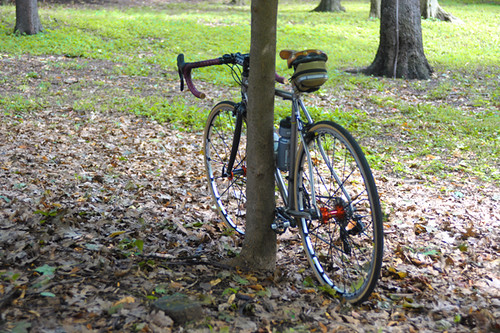Maude Catherine Wise Brubaker Yontz, my great grandmother, was the daughter of William Pythagrus and Sophia Dunfee Wise. She and her twin brother, Maurice James, were born on December 9, 1877 in Whitley County, Indiana. Maude passed away February 14, 1953 and was buried on my 5th birthday (so my mother has told me a zillion times, at least).
Maude lived with her parents and siblings on the family farm in Troy Township until her marriage on February 7, 1897 to Charles Romain "Romey" Brubaker who was born August 19, 1871 and was the son of William and Malissa Joslin Brubaker. He was 25 years old and she was 19. According to my grandmother, they eloped because her parents didn't approve of him. He didn't have a "steady" job and had a bit of wanderlust. He had lived in Chicago for a short time and in northern Michigan. I imagine they didn't think he could provide for her. When Maude and Romey went to her home to get her clothes and other things, her parents wouldn't let him in their house. Eventually, they accepted him but never did fully approve of him.
My grandmother wrote that "Romey and Maude set up housekeeping in Huntington, Indiana. They were very happy and carefree for a time. Then came the Spanish American War. Romey just didn't have a thought about enlisting; it seemed just a very small affair. But one day his mother drove down to Huntington and demanded that he enlist. She told him that his father would disown him if he didn't. Well, he enlisted and was soon in Cuba. He was a mess sergeant." [Updated 04/30: There is a separate post about Romey and some of his exploits.]
She continues, "While Romey was in the service of his country, Maude was trying to live her life as best she could. Mama was a very small girl, weighing only 98 pounds when she married and only 89 pounds while Papa was in the army. She was a brunette and very attractive. Mama had gone to live with Papa's parents. She and Grandma Brubaker never got along as both of them had terrible tempers. As she had very little to keep her busy, Mama got a job selling books about the Civil War so that she could be on her own some of the time. She always enjoyed meeting people and this was good therapy for her as she missed her husband so very much."
"In due time Papa came home; they lived on the farm at Goose Lake and Grandpa and Grandma moved into Columbia City where Uncle Hale entered high school. In February 1901, Mama gave birth to a little premature boy. John Wise Brubaker he was named but he lived only one week. He died in Mama's arms, this was a shock to Mama and she would talk of it for years. They buried him in Scott Cemetery just north of the schoolhouse where they both had gone to school. It is only about one mile from the farm."
Soon after the death of their little son, Maude and Romey moved to Lorain, Ohio where Maude's brother, Harry Wise, and their aunt, Rose Wise Zinsmeister, and their families lived. It was there that their second child, Hazlette Aileen, was born on January 16, 1902. She was also born premature, weighing only 2 1/2 pounds. When she was 6 months old, the family moved back to Whitley County. They lived on a small farm located a bit south of the Goose Lake farm. The following year, on April 14, 1903 another daughter, Choella Jane, was born. Not quite two years later, and a move to yet another farm, their fourth and last child, William Hale, was born on February 22, 1905.
Maude had some medical problems after the birth of William Hale and the family moved into Columbia City. The family moved a lot. They would live in a house for a few months then move to another, for no apparent reason. Maude was quite ill for several years and would have surgery in the spring of 1907. When she got out of the hospital they moved again, to another farm. During her illness Romey had been the dutiful husband - he had kept house, taken care of Maude and the children, and saw to their needs. But after Maude recovered from the surgery, he moved the family back to the Goose Lake farm then took off for Traverse City, Michigan. He had been there before they were married and liked the area. He rented a house, got it furnished, and sent for Maude and the children. My grandmother wrote of her memories of their time at Traverse City. It was an idyllic time, interrupted occasionally with a dose of reality.
On December 14, 1910 their world changed. They received a telegram that Romey's brother, Maurice Hale, had died of pneumonia while attending the Law College of Columbia University in New York City. The family left immediately for Whitley County, taking only what they could carry in their suitcases. Maude would return later to deal with their household goods, as reported in the Columbia City Post on Saturday January 14, 1911: "
Mrs. C.R. Brubaker, who went to Traverse City, Michigan, to look after the shipment of the household goods, was stormbound for three days and did not arrive here until Wednesday. A great snow storm was raging in northern Michigan. The C.R. Brubaker family will make their home with his father, Wm. Brubaker in Troy township."

At the Goose Lake Farm, about 1914: Thornton Brubaker (sitting on the stump, half-brother of William Brubaker), Jane, Orville Day (a hired man), Maude, Billy, Hazlette, Spot, and Charles Romain Brubaker.
So it was that the family returned to the Goose Lake farm. In the spring of 1911, William and Malissa moved to Columbia City leaving Romey to manage the farm. He must have liked it there, or perhaps had some sense of responsibility, for he and his family remained on the farm for six years. In her autobiography, grandma wrote quite a bit about their time at the farm. After several business deals went bad, they moved to North Webster in neighboring Kosciusko County. The farm was leased for a while to Uncle Harlow Barber (Maude's brother-in-law) but later sold. I'm not sure how long they lived in North Webster, probably just a few months. At any rate, they moved to Columbia City after leaving North Webster.
According to an article in the Columbia City Post dated January 15, 1919 Maude and Romey separated on September 15, 1917:
Maud Brubaker, who is now living on the south side, filed suit in the circuit court Monday for divorce from her husband, Charles R. Brubaker, better known in this city as Romey Brubaker. Her attorneys are Gates & Whiteleather.
She sets out in her complaint that they were married February 7, 1897, and that they separated on September 15, 1917. Her first cause for complaint is non-support, she is alleging that the defendant refused to support her and her children.
She charges further that the defendant was intoxicated most of the time. She avers that three years ago he inherited property worth four thousand dollars but that he squandered it on drink. That there were times when he would leave the house and be gone for several days and that she knew nothing about his whereabouts. That he would often bring liquor into the presence of his wife and children and that when the plaintiff objected he swore and cursed her; that he often brought friends home and would drink with them and that when she objected he said he could bring anyone he wished home and drink what he pleased. Then he enlisted in the army and that during that time she received the government allowance, but that since the time he was discharged he refused to support his wife. That the plaintiff was the owner of real estate in Troy township which was heavily encumbered and that the defendant refused to join with her in a deed so that she could sell the same. She asks for absolute divorce and the control and custody of her children.
They must have reconciled their differences, at least for a year or so - Charles and Maude were enumerated together, along with the children, on Line Street in Columbia City in the 1920 census. Records show that they were divorced on April 13, 1921.
Romey moved to Pascagoula, Mississippi. I haven't found his World War I service records yet or even a mention of it in the local newspapers, but I think he must have been stationed in Mississippi during his time in service. That's the only reason I have come up with for his moving there. On April 1, 1923 he married Viola Fagan. Romey remained in Pascagoula the rest of his life, although he did return to Whitley County at least once to visit his mother. He passed away on December 19, 1945 at the Veteran's Hospital in Biloxi, Mississippi.
Maude remained in Columbia City where, on January 30, 1922 she married Joseph Yontz. My mother and her sisters have fond memories of visiting Maude and Joe. Aunt Phyllis says they were a very happy couple and were wonderful grandparents. Joe passed away on December 9, 1948. Maude would live another four years, passing away on February 14, 1953 of complications from diabetes.

Maude and her 2nd husband, Joseph Yontz. They were married January 30, 1922 when she was 44 years old and he was 50. This could be their wedding picture.
One of the things that always confused me was when mom and her siblings spoke of Maude they always called her "Grandma Bill." Mom explained that one day Maude and her son, Bill, came to visit. The kids all ran out yelling "Grandma" and "Uncle Bill" over and over, until it became "Grandma Bill" and the name stuck. From that day forward, she was always Grandma Bill. And Joseph Yontz was Grandpa Joe.
 Maude and her granddaughter, Phyllis Phend, 1924.
Maude and her granddaughter, Phyllis Phend, 1924.
 Twenty years or so later, about 1945-46, four generations. Phyllis Phend Mitchell, her children Mike and Kathy, with Gram "Bill" (Maude Wise Brubaker Yontz) and her daughter, Gram Dunn (Hazlette Brubaker Phend Dunn).
Twenty years or so later, about 1945-46, four generations. Phyllis Phend Mitchell, her children Mike and Kathy, with Gram "Bill" (Maude Wise Brubaker Yontz) and her daughter, Gram Dunn (Hazlette Brubaker Phend Dunn).
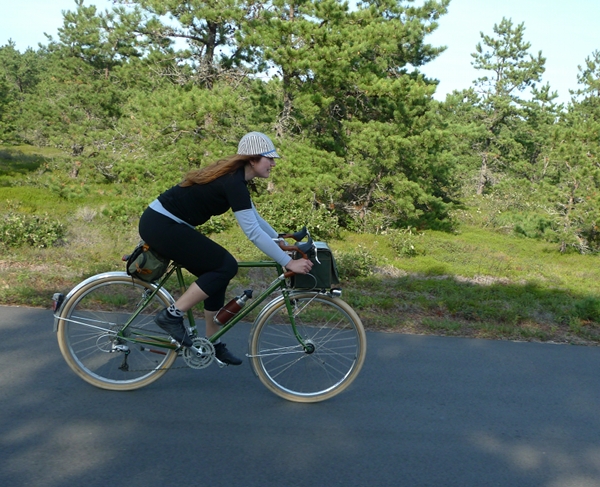 Upon returning to the city and getting on my Gazelle again, I was surprised by how different the cycling experience felt from being on my Rivendell.
Upon returning to the city and getting on my Gazelle again, I was surprised by how different the cycling experience felt from being on my Rivendell. Normally, I ride both bicycles regularly, so the switch back and forth does not feel remarkable. But after having cycled solely on a roadbike for three weeks, I almost felt as if I had to forcefully uncurl my spine as I transformed from a quadruped to a biped.
Normally, I ride both bicycles regularly, so the switch back and forth does not feel remarkable. But after having cycled solely on a roadbike for three weeks, I almost felt as if I had to forcefully uncurl my spine as I transformed from a quadruped to a biped.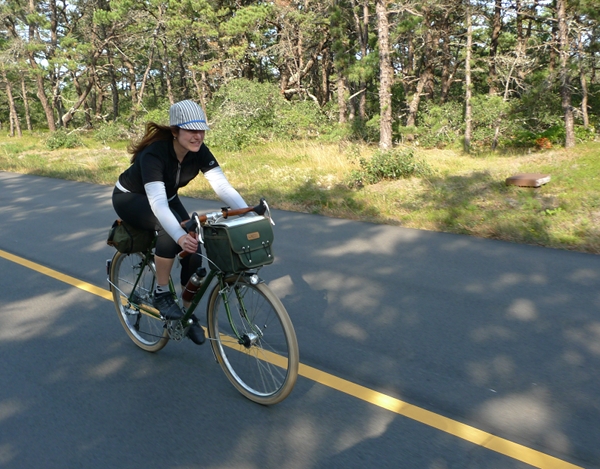 While we were away, the Co-Habitant teased that I would get accustomed to using a roadbike for transportation and would probably just keep doing it when we got home - after all, it's faster. But it soon became clear that when it comes to upright bicycles, absence made the heart grow fonder. (Now, if I can just stop trying to use the non-existent bar-end shifters on my poor Dutch bike!)
While we were away, the Co-Habitant teased that I would get accustomed to using a roadbike for transportation and would probably just keep doing it when we got home - after all, it's faster. But it soon became clear that when it comes to upright bicycles, absence made the heart grow fonder. (Now, if I can just stop trying to use the non-existent bar-end shifters on my poor Dutch bike!) I think that as upright mammals, we are accustomed to seeing the world from the vantage point of bipedalism and we feel the most relaxed when adopting that posture.It is only natural that people prefer to remain upright when moving through their environment - whether on foot, or on bike, or on public transport. While upright bicycles may not be appropriate for sport or long distance travel, their importance in the realm of "normal cycling" cannot be overstated. Most people considering a bicycle for transportation do not see themselves as "cyclists". They want to be their usual selves, except on a bike. I think the ability to remain an upright mammal is crucial to retaining one's inherent sense of self while cycling for transportation.
I think that as upright mammals, we are accustomed to seeing the world from the vantage point of bipedalism and we feel the most relaxed when adopting that posture.It is only natural that people prefer to remain upright when moving through their environment - whether on foot, or on bike, or on public transport. While upright bicycles may not be appropriate for sport or long distance travel, their importance in the realm of "normal cycling" cannot be overstated. Most people considering a bicycle for transportation do not see themselves as "cyclists". They want to be their usual selves, except on a bike. I think the ability to remain an upright mammal is crucial to retaining one's inherent sense of self while cycling for transportation.












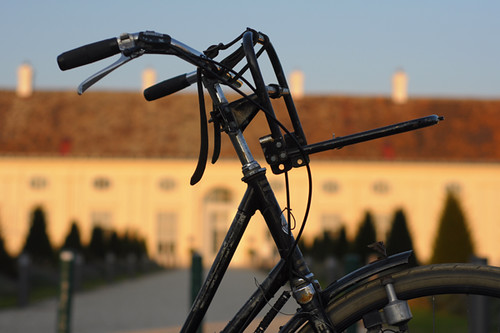 From the first time I rode a vintageSteyrWaffenrad in Vienna two years ago, its handling impressed me as unusual; categorically different from other classic city bikes I've tried, vintage or modern. Despite being large and heavy, the bicycle is extremely maneuverable.The cycling paths in Vienna are narrow and twisty, often requiring cyclists to make tight turns. I can do so on this bike at speed, without much effort. I cannot make the same turns on myGazelleat home, or even on my roadbikes, in the same easy manner. Additionally, the bike feels easy to control and "place" when going downhill. In the summer of I rode it up an then down a small mountain on the outskirts of town via a winding road. I thought I'd be riding the brake the entire way down, but the bike was able to follow the curve of the road with extreme precision.
From the first time I rode a vintageSteyrWaffenrad in Vienna two years ago, its handling impressed me as unusual; categorically different from other classic city bikes I've tried, vintage or modern. Despite being large and heavy, the bicycle is extremely maneuverable.The cycling paths in Vienna are narrow and twisty, often requiring cyclists to make tight turns. I can do so on this bike at speed, without much effort. I cannot make the same turns on myGazelleat home, or even on my roadbikes, in the same easy manner. Additionally, the bike feels easy to control and "place" when going downhill. In the summer of I rode it up an then down a small mountain on the outskirts of town via a winding road. I thought I'd be riding the brake the entire way down, but the bike was able to follow the curve of the road with extreme precision.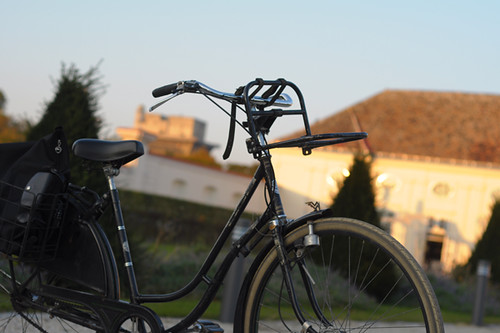 On the downside, I have already mentioned that the front end handling at slow speeds takes getting used to, requiring a very light touch. When I first start riding this bike after a long absence, it shakes so much that I always wonder whether the front wheel is loose. Then my body adapts to the handling and the shaking stops. Weird how that happens, and I even tell myself "Don't worry, remember that if felt the same way last time and then you got used to it." An hour later, I am invariably convinced that it is the best-handling bicycle in the world.
On the downside, I have already mentioned that the front end handling at slow speeds takes getting used to, requiring a very light touch. When I first start riding this bike after a long absence, it shakes so much that I always wonder whether the front wheel is loose. Then my body adapts to the handling and the shaking stops. Weird how that happens, and I even tell myself "Don't worry, remember that if felt the same way last time and then you got used to it." An hour later, I am invariably convinced that it is the best-handling bicycle in the world.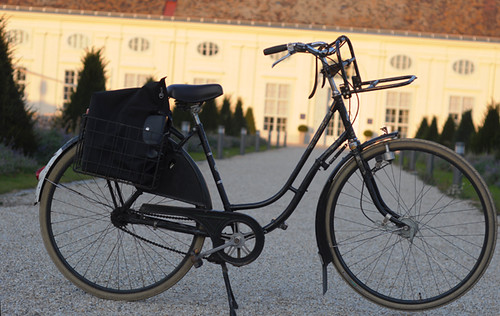 While I've felt these things on Jacqueline from the beginning, it was only later that I made the connection between these characteristics and low-trail geometry. I asked Wolfgang, the bike's owner about it, and while he does not recall the exact figure, he does believe it is a low trail bike. He also agrees that the SteyrWaffenrad bicycles have unique handling compared to other seemingly-similar city bikes. As someone whose cycling experience ranges from the velodrome to climbing the Grossglockner, he prefers this model as his own city bike and owns at least half dozen of them from different decades.
While I've felt these things on Jacqueline from the beginning, it was only later that I made the connection between these characteristics and low-trail geometry. I asked Wolfgang, the bike's owner about it, and while he does not recall the exact figure, he does believe it is a low trail bike. He also agrees that the SteyrWaffenrad bicycles have unique handling compared to other seemingly-similar city bikes. As someone whose cycling experience ranges from the velodrome to climbing the Grossglockner, he prefers this model as his own city bike and owns at least half dozen of them from different decades.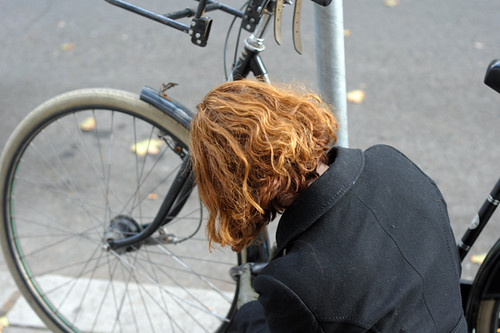 I will be leaving Vienna soon, and Jacqueline has already been returned to her owner. Wolfgang has an extra Steyr Waffenrad frame that can be mine if I want it, and I've been toying with the idea of building one up to see how it rides in Boston.I don't know though, it almost seems "wrong" somehow, as if Jacqueline belongs in Vienna. Of course the Boston version would be Jacqueline II... Funny how every now and again I think that I'm "done" with experimenting! But I do need to learn how to measure a bike properly - including angles, rake and trail.
I will be leaving Vienna soon, and Jacqueline has already been returned to her owner. Wolfgang has an extra Steyr Waffenrad frame that can be mine if I want it, and I've been toying with the idea of building one up to see how it rides in Boston.I don't know though, it almost seems "wrong" somehow, as if Jacqueline belongs in Vienna. Of course the Boston version would be Jacqueline II... Funny how every now and again I think that I'm "done" with experimenting! But I do need to learn how to measure a bike properly - including angles, rake and trail.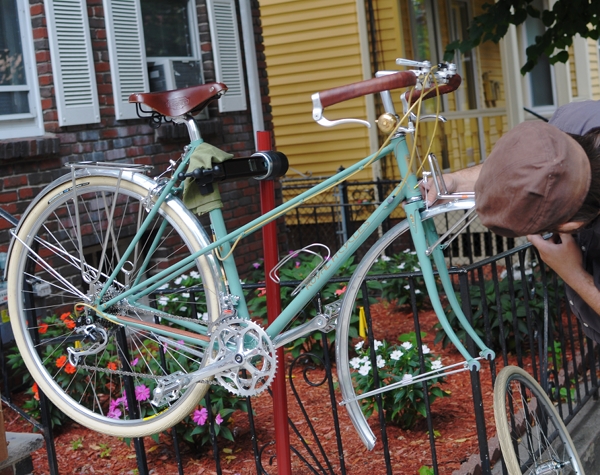
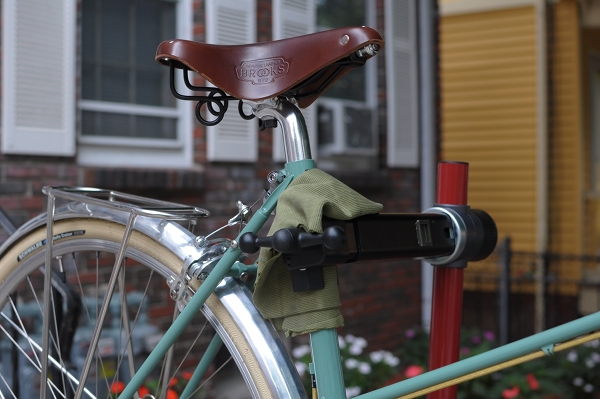


 At the Goose Lake Farm, about 1914: Thornton Brubaker (sitting on the stump, half-brother of William Brubaker), Jane, Orville Day (a hired man), Maude, Billy, Hazlette, Spot, and Charles Romain Brubaker.
At the Goose Lake Farm, about 1914: Thornton Brubaker (sitting on the stump, half-brother of William Brubaker), Jane, Orville Day (a hired man), Maude, Billy, Hazlette, Spot, and Charles Romain Brubaker. Maude and her 2nd husband, Joseph Yontz. They were married January 30, 1922 when she was 44 years old and he was 50. This could be their wedding picture.
Maude and her 2nd husband, Joseph Yontz. They were married January 30, 1922 when she was 44 years old and he was 50. This could be their wedding picture. Maude and her granddaughter, Phyllis Phend, 1924.
Maude and her granddaughter, Phyllis Phend, 1924.  Twenty years or so later, about 1945-46, four generations. Phyllis Phend Mitchell, her children Mike and Kathy, with Gram "Bill" (Maude Wise Brubaker Yontz) and her daughter, Gram Dunn (Hazlette Brubaker Phend Dunn).
Twenty years or so later, about 1945-46, four generations. Phyllis Phend Mitchell, her children Mike and Kathy, with Gram "Bill" (Maude Wise Brubaker Yontz) and her daughter, Gram Dunn (Hazlette Brubaker Phend Dunn).  Hidden amongst the shadows of the morning light, the trail winds its way along the Zion Canyon Valley, up that “short” wall on the left, through Refrigerator Canyon, up to the West Rim and on towards Angels Landing (the top of that center peak).
Hidden amongst the shadows of the morning light, the trail winds its way along the Zion Canyon Valley, up that “short” wall on the left, through Refrigerator Canyon, up to the West Rim and on towards Angels Landing (the top of that center peak). Actually, even in the full light of day, the trail is discernible from ground level only in a few places (like that diagonal “line” towards the top of the short wall).
Actually, even in the full light of day, the trail is discernible from ground level only in a few places (like that diagonal “line” towards the top of the short wall). Heartbreak hill. That's what I called this steep section nearly a mile into the trail. It's that “diagonal line” shown in the previous photo. And it seems like it will never end. And what's around the corner? Why, yet another steep section!
Heartbreak hill. That's what I called this steep section nearly a mile into the trail. It's that “diagonal line” shown in the previous photo. And it seems like it will never end. And what's around the corner? Why, yet another steep section! Taken on the way back down, this shows the switchbacks that had to be navigated before getting to the steep section shown in the previous photo.
Taken on the way back down, this shows the switchbacks that had to be navigated before getting to the steep section shown in the previous photo. The trail weaves its way though the Zion Canyon Valley. Looking back towards the start of the trail on the other side of the river (photo taken on the way back down).
The trail weaves its way though the Zion Canyon Valley. Looking back towards the start of the trail on the other side of the river (photo taken on the way back down). After nearly a mile through Refrigerator Canyon, you get to Walter's Wiggles, comprised of 21 short but very steep switchbacks and named after Walter Ruesch, the first superintendent of Zion National Park. In 1924, he helped design and engineer these switchbacks. (Photo taken on the way back down.)
After nearly a mile through Refrigerator Canyon, you get to Walter's Wiggles, comprised of 21 short but very steep switchbacks and named after Walter Ruesch, the first superintendent of Zion National Park. In 1924, he helped design and engineer these switchbacks. (Photo taken on the way back down.) Ascending the last of Walter's Wiggles you arrive at a broad area called Scout Lookout. There is more to come, and believe it or not, the easiest part is behind you!
Ascending the last of Walter's Wiggles you arrive at a broad area called Scout Lookout. There is more to come, and believe it or not, the easiest part is behind you!